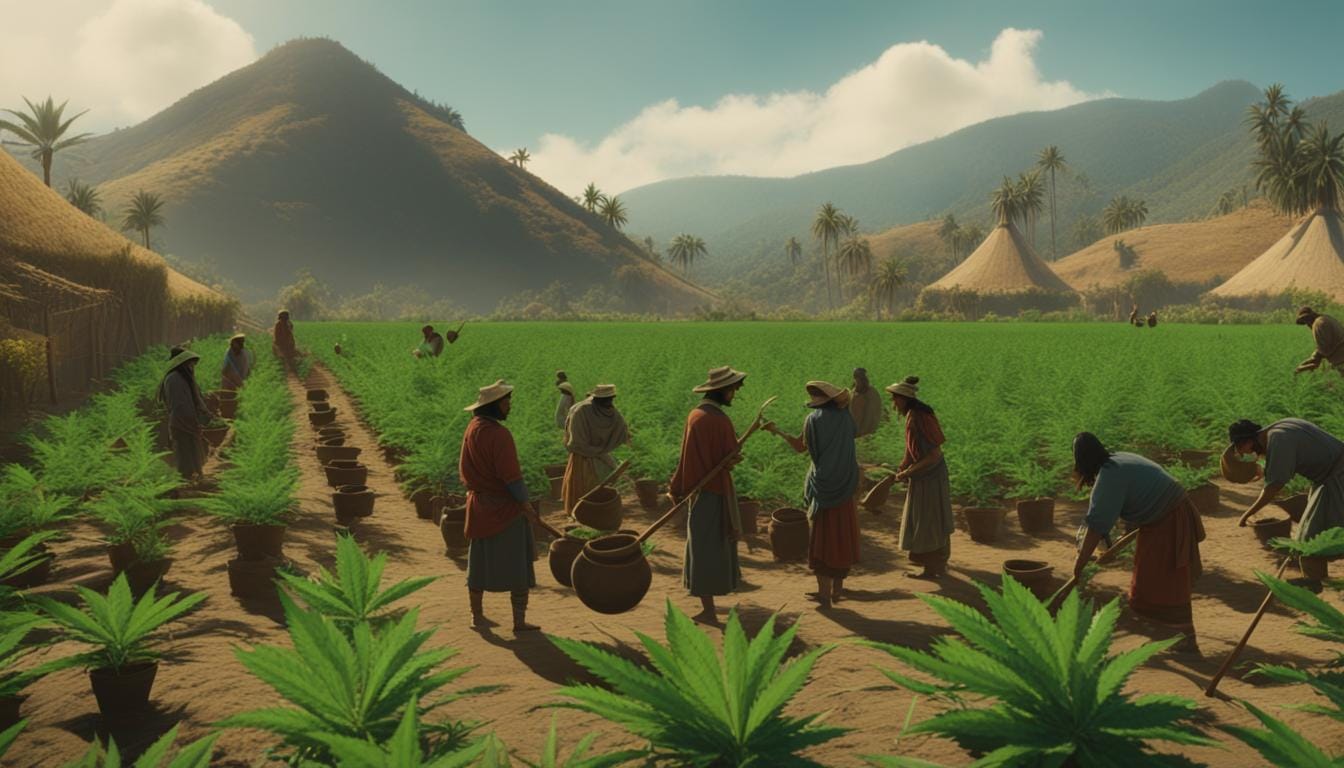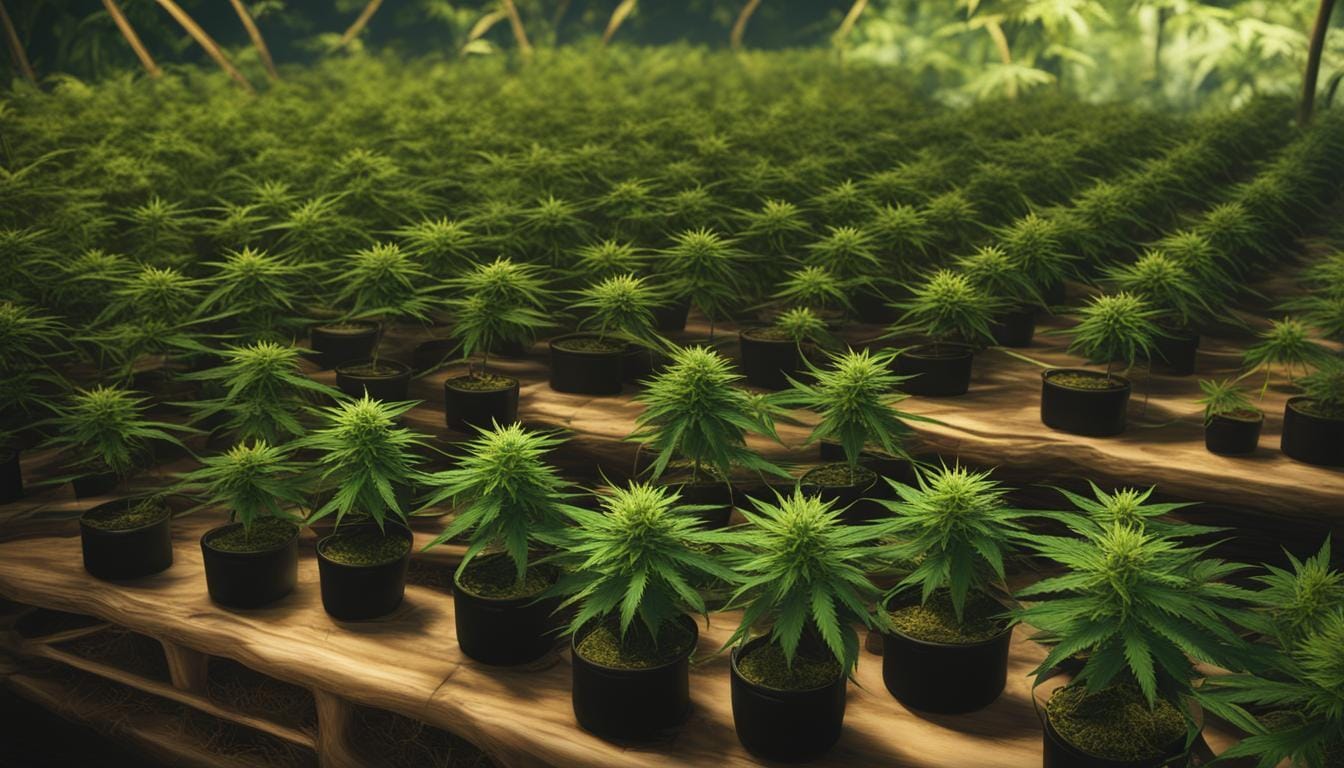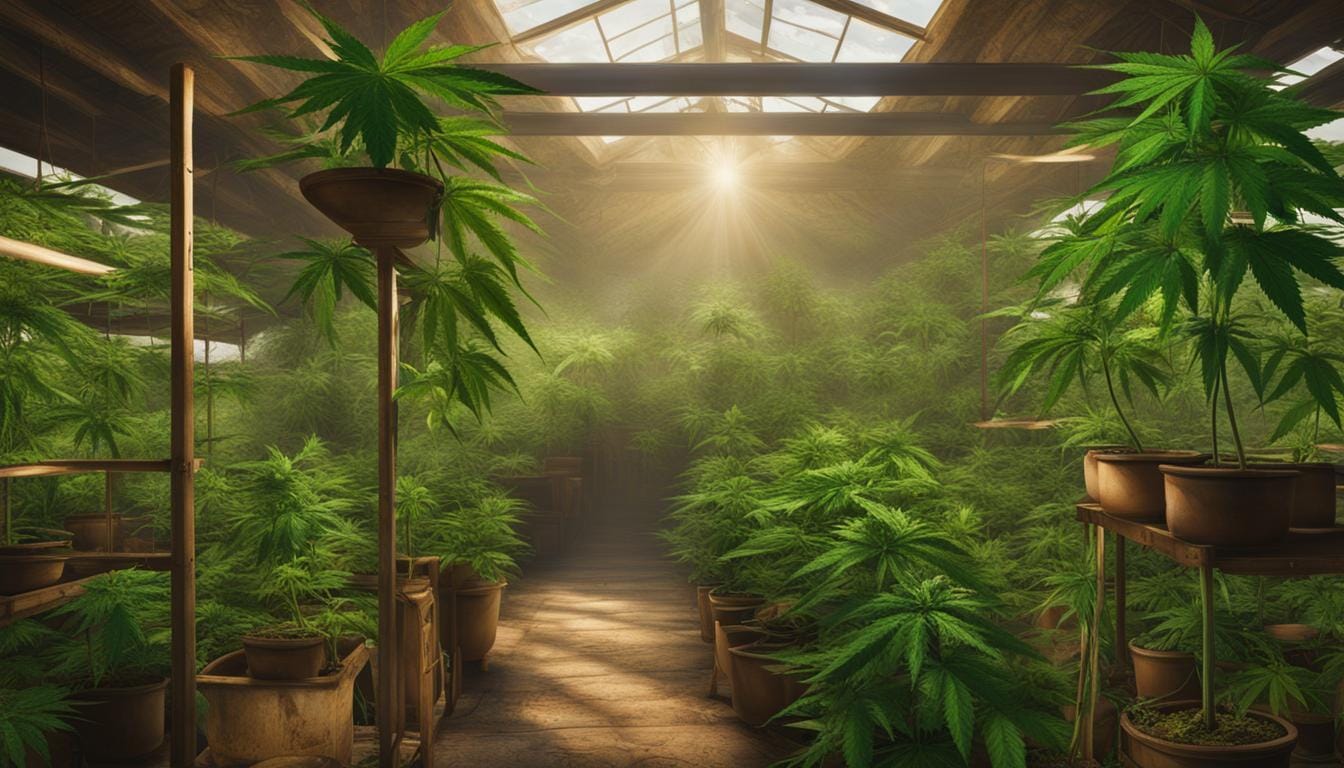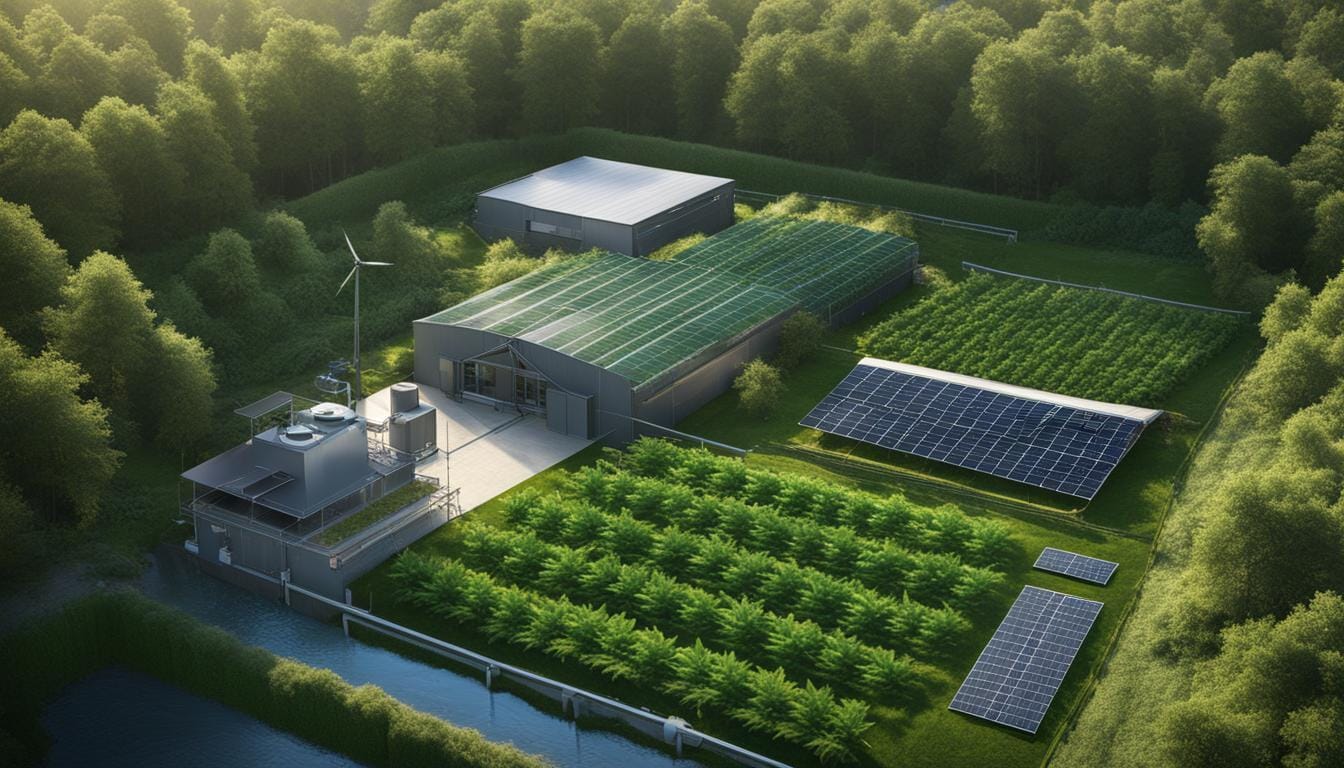The Complete History of Cannabis Cultivation

Welcome to the world of cannabis cultivation! In this article, we will explore the fascinating history of marijuana farming and how it has evolved throughout the years. From the ancient techniques of cultivation to the modern methods of farming, we will take you on a journey through the entire history of cannabis cultivation.
Humans have been growing cannabis for thousands of years, and its cultivation has played a significant role in various cultures. The history of cannabis farming is full of interesting facts and stories, and we are excited to share them with you in this section.
Key Takeaways:
- The history of cannabis cultivation dates back thousands of years
- Cannabis cultivation has played a significant role in various cultures throughout history
- The timeline of cannabis cultivation covers ancient methods of growing cannabis to modern techniques of farming
- The history of cannabis farming is full of interesting stories and facts
- Cannabis cultivation has had a significant impact on society in many different ways
History of Cannabis Cultivation
As we delve into the history of cannabis cultivation, it’s interesting to note that the origins of marijuana cultivation can be traced back to ancient times. The early cultivation of cannabis can be traced back to Asia and the Middle East, where it was grown for medicinal and religious purposes.
The cultivation of cannabis spread to other parts of the world, including Europe, Africa, and the Americas, where it was primarily used for fiber production. In fact, the first recorded use of cannabis as a fiber was in China more than 10,000 years ago.
However, the use of cannabis for medicinal and religious purposes continued to be prevalent in various cultures throughout history. In ancient Egypt, cannabis was used for medicinal purposes, and evidence of cannabis use has been found in the remains of ancient Greek and Roman civilizations.
Introduction of Cultivation for Recreational Use
As time passed, the cultivation of cannabis began to shift from primarily medicinal and religious use to recreational use. This shift was driven in part by the discovery of the psychoactive properties of the plant.
The first recorded use of cannabis for recreational purposes was in India in the 8th century CE. Cannabis was consumed in the form of bhang, a drink made from ground cannabis leaves and seeds mixed with milk and spices.
Over time, the use of cannabis for recreational purposes spread to other parts of the world, including Europe and the Americas. Today, recreational cannabis use is legal in several states in the USA and countries such as Canada and Uruguay.
“The early cultivation of cannabis can be traced back to Asia and the Middle East, where it was grown for medicinal and religious purposes.”

Evolution of Cannabis Growing Techniques
Over time, cannabis cultivation techniques have evolved significantly, resulting in improved quality and higher yields. The historical development of cannabis cultivation is a fascinating topic, and the innovations in modern techniques have greatly influenced the industry, making it more efficient and sustainable. In this section, we will explore the evolution of cannabis growing techniques and how they have changed over time to meet the demands of the market.
One of the earliest cultivation techniques involved planting cannabis seeds in the ground and allowing them to grow naturally. However, as people learned more about cannabis, they began to experiment with different methods, such as cloning and crossbreeding. These techniques helped create new varieties of cannabis that were more resilient and had unique properties.
As the demand for cannabis grew, so did the need for more efficient cultivation practices. Modern growers began to experiment with hydroponics, a soilless method of growing plants that allowed for better control over environmental factors such as water, nutrients, and light. This resulted in higher yields and improved quality.
Another innovation in modern techniques is the use of LED lights for indoor cultivation. LED lights provide the optimal spectrum of light for cannabis plants, resulting in faster growth and higher yields. Additionally, LED lights are more energy-efficient and have a longer lifespan than traditional lighting methods.
| Cultivation Technique | Description |
|---|---|
| Cloning | A method of asexual reproduction that involves taking a cutting from a cannabis plant and rooting it to create a genetically identical plant |
| Crossbreeding | The process of breeding two different strains of cannabis to create a new variety with desirable traits |
| Hydroponics | A method of growing plants without soil, using a nutrient-rich water solution instead |
| LED Lighting | A type of lighting used in indoor cultivation that provides the optimal spectrum of light for cannabis plants |
As cannabis cultivation techniques continue to evolve, growers are also exploring more sustainable and environmentally friendly practices. For example, some farmers are using organic pest control methods and sustainable soil management techniques to reduce the use of harmful chemicals and promote soil health. These practices not only benefit the environment but also result in healthier, more flavorful cannabis.
Without a doubt, the evolution of cannabis growing techniques has come a long way since the early days of planting seeds in the ground. From cloning and crossbreeding to hydroponics and LED lighting, the industry has experienced significant advancements that have greatly impacted the quality and yield of cannabis plants. As we continue to explore sustainable and environmentally friendly practices, we can expect even more innovations in the future.
Historical Cultivation Practices of Cannabis
As we delve deeper into the history of cannabis cultivation, it’s clear that traditional methods of growing marijuana have played a significant role in shaping the industry. The cultivation practices used in different regions and their cultural significance have led to various techniques that have been passed down for generations.
One such method is the “finger hash” technique, which involves rubbing marijuana plants with one’s fingers to collect the resin. This technique was commonly used in the Hindu Kush region and is still used today.
Another traditional method of growing cannabis is the “guerrilla farming” technique, which involves planting cannabis in remote areas away from prying eyes. This technique was used by growers in the 1960s to avoid arrest and is still used today by illegal cultivators.
In places like Morocco, the “dry sift” technique is still used to extract trichomes from cannabis plants. This method involves sifting the cannabis through a silk screen to collect the trichomes.
| Cultivation Practice | Region |
|---|---|
| Finger Hash | Hindu Kush |
| Guerrilla Farming | Worldwide |
| Dry Sift | Morocco |
These cultivation practices have a deep cultural significance in the regions where they originated. Many growers continue to use these techniques today as a way to honor their cultural heritage.
However, as the cannabis industry grows and becomes more regulated, many traditional methods of growing marijuana have been replaced by modern cultivation practices. These modern techniques often produce higher yields and better quality cannabis, but they lack the cultural significance of traditional methods.
Despite this shift, traditional cultivation practices remain an important part of the history of cannabis cultivation, and their influence can still be seen in the industry today.
Ancient Methods of Growing Cannabis
The cultivation of cannabis has been around for thousands of years, with evidence of its use dating back to ancient civilizations such as China and India. The early cultivation of cannabis was quite different from modern techniques, but it was an essential practice for these cultures.
One of the earliest methods of growing cannabis was a technique called “scraping.” This involved scraping the outer layer of the cannabis plant to expose the inner fibers. This technique was used to create materials such as clothing, rope, and paper.
Another ancient method of growing cannabis was through the use of irrigation systems. In ancient Egypt, for example, farmers used the annual flooding of the Nile River to irrigate their cannabis crops. This allowed them to cultivate the plants in areas that were otherwise not suitable for farming.
The use of natural fertilizers was also a common practice in ancient cannabis cultivation. Farmers would use animal manure and other organic materials to enrich the soil and promote plant growth.
The Benefits of Ancient Cannabis Cultivation Methods
While these ancient methods of growing cannabis may seem primitive by modern standards, they were incredibly effective for their time. Scraping allowed for the creation of essential materials, while irrigation systems and natural fertilizers made it possible to cultivate crops in areas that were otherwise unusable.
Additionally, these methods were sustainable and environmentally friendly. Unlike modern farming techniques that rely heavily on synthetic fertilizers and pesticides, ancient cannabis cultivation practices were in harmony with nature and did not cause harm to the environment.
“The early cultivation of cannabis was quite different from modern techniques, but it was an essential practice for these cultures.”
The Influence of Ancient Cannabis Cultivation Today
Today, modern cannabis farmers have begun to take inspiration from these ancient cultivation practices. Many growers are now focusing on sustainable and environmentally friendly methods, such as using natural fertilizers and practicing organic farming.
Additionally, the use of irrigation and other water conservation techniques has become increasingly popular, particularly in areas where water resources are limited.
Overall, the ancient methods of growing cannabis continue to influence modern cultivation practices. They serve as a reminder that sustainable and environmentally friendly farming practices are essential for the long-term health and viability of the cannabis industry.

The Significance of Cannabis Farming
As we delved into the history of cannabis cultivation, we discovered the immense historical significance of this plant and its farming practices. Cannabis has played a significant role in various cultures over the centuries, impacting not only the economy but also social and cultural aspects of society.
For example, in ancient China, cannabis was cultivated for its strong and durable fibers, which were used to make clothing, paper, and other essential goods. Cannabis was also valued for its medicinal properties and was used to treat various ailments.
In colonial America, hemp was extensively cultivated for use in shipbuilding, paper production, and textiles. Hemp was also used as currency, and farmers were encouraged to grow it as it was seen as a crucial cash crop.
The historical significance of cannabis farming can also be seen in the role it played in the war effort during World War II. The US government incentivized farmers to grow hemp for use in the production of ropes and other materials needed for the war effort.
Today, the cannabis industry has a significant economic impact, with the global market projected to reach $73.6 billion by 2027. The legalization of cannabis in various parts of the world has led to the creation of new jobs and business opportunities. The industry has also spurred innovation, leading to the development of new products and technologies.
However, cannabis farming also faces regulatory challenges and the need for sustainable and environmentally friendly practices. As legalization continues to spread, farmers must navigate changing regulations and ensure their practices are ethical and sustainable.
Indeed, the historical significance of cannabis farming cannot be overstated. From its early origins to its modern-day impact, cannabis has played a crucial role in shaping various aspects of society.
The Rise of Commercial Cultivation
As the demand for cannabis increased, so did the need for larger-scale production. This led to the rise of commercial cultivation, which saw a shift from small-scale production to large-scale farming. The increasing legalization of cannabis also played a significant role in the growth of commercial production.
In the United States, states that have legalized cannabis for both medical and recreational purposes have seen a significant increase in commercial cultivation. According to a report by Grand View Research, the global legal marijuana market is expected to reach $73.6 billion by 2027, with North America accounting for the majority of the revenue.
While commercial cultivation has its advantages, such as increased production and profitability, it also presents its own set of challenges. The cost of running a large-scale operation can be significant, and regulations can vary from state to state, making compliance a complex and time-consuming process. Furthermore, the use of pesticides and other chemicals in commercial cultivation can have significant environmental impacts.
Despite these challenges, the rise of commercial cultivation has revolutionized the cannabis industry. Large-scale operations can produce consistent, high-quality products at a lower cost, making cannabis more accessible to consumers. As the industry continues to evolve, it will be interesting to see how commercial cultivation practices continue to adapt to meet the growing demand for cannabis.
Introduction of Modern Techniques
As cannabis cultivation continues to evolve, modern techniques have played a significant role in advancing the industry. These techniques have revolutionized the way we grow cannabis, leading to increased yields, improved quality, and greater efficiency.
One of the most significant modern techniques in cannabis cultivation is the use of hydroponics. Hydroponics is a soil-less growing method that allows cultivators to grow cannabis in a controlled environment. It involves growing plants in a nutrient-rich solution that is circulated through a water system, allowing for precise control over the plant’s nutrients and water intake.
Another modern technique that has gained popularity is the use of LED lighting. Compared to traditional lighting methods, LED lights consume less energy and emit less heat, making them a more efficient and cost-effective alternative. Additionally, LED lights can be customized to provide specific light spectrums that cater to different stages of growth, further improving plant development.
Modern cultivation techniques have also led to the development of new strains of cannabis. Through crossbreeding and genetic modification, cultivators can create strains that have specific properties, such as higher THC levels or unique flavor profiles.
Finally, modern technology has allowed for greater automation in cannabis cultivation. Automated systems for watering, nutrient delivery, and environment control have made it easier for cultivators to manage large-scale operations efficiently.
Overall, the introduction of modern techniques has greatly impacted the cannabis industry, leading to improved quality and efficiency. As technology continues to advance, we can expect to see further innovations that will shape the future of cannabis cultivation.
Sustainable and Environmentally Friendly Practices
As a responsible cannabis cultivator, I understand the importance of sustainable and environmentally friendly practices. With the increasing demand for cannabis products, it is crucial to ensure that we are growing high-quality plants while also protecting the environment.
One way to implement sustainable practices is by using organic growing methods. By using organic fertilizers, compost tea, and other natural products, we can avoid harmful chemicals that may harm the environment and our health. Additionally, this can increase the nutritional value of the plant, creating a healthier end-product for consumers.
The Benefits of Sustainable Cannabis Cultivation Practices
Implementing sustainable cannabis cultivation practices has numerous benefits. First, it can increase the quality and yield of the plants, leading to higher profits in the long term. Secondly, sustainable practices can help reduce the carbon footprint of the cannabis industry, creating a more environmentally friendly and socially responsible industry.
Here are some sustainable practices that I implement in my cannabis cultivation:
| Sustainable Practice | Description |
|---|---|
| Water conservation | I utilize a drip irrigation system that reduces water waste and promotes efficient water use. |
| Composting | I compost plant waste to create natural fertilizers that can be used in the next growing season. |
| Integrated Pest Management | I use a combination of natural pest control methods such as beneficial insects and companion planting to reduce the use of chemical pesticides. |
By implementing these sustainable practices, I am not only producing high-quality cannabis but also contributing to the overall well-being of the planet.
The Importance of Environmentally-Friendly Cannabis Farming
Environmentally-friendly cannabis farming is essential to reduce the negative impact of the cannabis industry on the environment. Cannabis farming can have a significant impact on the surrounding ecosystem, including soil and water quality, wildlife habitat, and air pollution. By implementing environmentally friendly practices, we can reduce this impact and create a sustainable future for the cannabis industry.
Here are some of the benefits of environmentally-friendly cannabis farming:
- Reduced carbon footprint
- Improved soil and water quality
- Increased biodiversity
- Reduced use of pesticides and chemicals

Regulatory Changes and Challenges
As the cannabis industry continues to grow, we have seen a significant shift in the regulatory landscape. The legalization of cannabis in several states has led to a wave of new regulations and policies that have impacted cultivation practices. These changes have created both opportunities and challenges for cannabis cultivators.
One of the most significant regulatory changes in the cannabis industry has been the move toward legalization. With more and more states legalizing cannabis for medical and recreational use, cultivators have had to adapt to new regulations and guidelines. These regulations cover everything from licensing requirements to quality control standards.
Another challenge facing cannabis cultivators is the lack of federal regulation. While some states have legalized cannabis, it is still a Schedule 1 drug at the federal level. This means that there are no clear federal guidelines for cultivators to follow, leaving them to navigate a complex and often unclear regulatory landscape.
Despite these challenges, many cultivators have found ways to thrive in the new regulatory environment. Some have focused on developing sustainable and environmentally friendly cultivation practices in response to increased public scrutiny. Others have turned to technology, using innovative solutions to improve efficiency and productivity while staying compliant with regulations.
The regulatory changes and challenges facing the cannabis industry have had a significant impact on cultivation practices. While these changes have created new opportunities, they have also presented new challenges that cultivators must navigate. Through innovation and adaptation, cultivators can continue to thrive in this rapidly evolving industry.
The History of Cannabis Cultivation: Conclusion
Exploring the history of cannabis cultivation has highlighted the significance of this plant throughout human history. From the earliest cultivation practices in ancient times to the revolutionary modern techniques of today, cannabis has undergone an evolution that has shaped cultures and societies worldwide.
As cannabis farming continues to shift towards larger commercial operations, it is essential to maintain sustainable and environmentally friendly practices. The responsibility of cultivators extends to regulation compliance, ensuring that policies designed to protect and standardize the industry are adhered to.
Despite the legal and regulatory challenges, the future of cannabis cultivation looks bright. As society becomes more accepting of the potential benefits of cannabis, its cultivation and use are expected to grow. With continued innovation, research, and cultivation techniques, this industry is poised to thrive in the years to come.
Now that you know all about the history of cannabis cultivation, check out the collection of regular, feminized, and autoflower cannabis seeds at Seeds Here Now.
FAQ
What is the history of cannabis cultivation?
Cannabis cultivation has been practiced for thousands of years, dating back to ancient civilizations. It has a rich history and has evolved significantly over time.
Where did marijuana cultivation originate?
Marijuana cultivation originated in various regions, including Central Asia, where it was first domesticated. It then spread to different parts of the world through trade and exploration.
How have cannabis growing techniques evolved?
Cannabis growing techniques have evolved through advancements in agricultural practices, technology, and scientific research. Growers have continually refined cultivation methods to maximize plant health and yield.
What were the historical cultivation practices of cannabis?
Historical cultivation practices of cannabis varied across different cultures and regions. Traditional methods involved planting, nurturing, and harvesting cannabis plants using techniques specific to each society.
What were the ancient methods of growing cannabis?
Ancient cultures employed various methods to grow cannabis, including using handmade tools, natural fertilizers, and specific planting and harvesting rituals unique to their traditions.
What is the historical significance of cannabis farming?
Cannabis farming has played a significant role throughout history. It has provided economic opportunities, acted as a cultural symbol, and even had spiritual and medicinal significance in different societies.
How has commercial cultivation of cannabis changed?
Commercial cultivation of cannabis has grown exponentially in recent years. With the legalization and increased demand for cannabis products, larger-scale farming operations have emerged to meet market needs.
What are the modern techniques of cannabis cultivation?
Modern techniques of cannabis cultivation include advanced equipment, hydroponics, indoor grow operations, artificial lighting, optimized nutrient solutions, and genetic advancements through selective breeding.
Are there sustainable and environmentally friendly practices in cannabis cultivation?
Yes, there are sustainable and environmentally friendly practices in cannabis cultivation. These include organic farming methods, water conservation, energy-efficient technologies, and responsible waste management.
What regulatory changes and challenges exist for cannabis cultivators?
Cannabis cultivators face regulatory changes and challenges related to licensing, compliance, taxation, and varying regulations in different jurisdictions. Keeping up with evolving legislation is crucial for cultivators.
Suggested Articles
;)
;)
;)




 03 Jul 2025
03 Jul 2025  10 min read
10 min read


 December 12, 2023
December 12, 2023 


RESPONSES (0)
No responses yet. Be the first to respond!